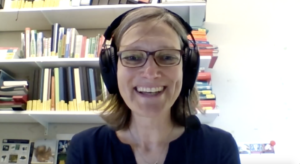A steep learning curve during the coronavirus pandemic

Arriving at the university at the same time as the pandemic
Education specialist Prof. Dr. Svenja Bedenlier started as an assistant professor at the Department of Education and at the Innovation in Learning Institute (ILI) at FAU in March. She reports back on the effects the coronavirus pandemic has had on her teaching in the summer semester.
I arrived at the university just as the coronavirus pandemic started.
I had only been at FAU for two weeks when we were all officially instructed to work from home. I have not yet used any of the seminar rooms at FAU, and have offered all my teaching online. The StudOn study platform was entirely new to me. I have learnt a huge amount during the coronavirus pandemic, with a very steep learning curve. It also showed me just what is possible at a large university which is usually focused on face-to-face teaching like FAU. A challenging situation, which forced a lot of people to venture outside their comfort zone: lecturers, students, basically the whole of the university. Even though ILI has been preparing for and supporting a gradual and didactically sound integration of digital elements into teaching, this semester was a truly exceptional situation. It showed me that content can be taught well online, but for me personally I found it disappointing to just be faced with the white wall behind the laptop after each Zoom session, without being able to get to know my students properly.
Challenges of online teaching
In my opinion, purely online teaching is less spontaneous: if I am in a seminar room with a group of students, it is much easier for me to judge reactions. If I can see the students’ expressions or gestures, if I can tell if someone is listening attentively, looking lost or just playing with their mobile phone, then I can react quite differently in a face-to-face teaching session. It is very hard to communicate effectively if the majority of my approximately thirty students leave their microphones and cameras switched off. You know someone is there, but it’s hard to get a proper feeling for each other. Blended learning formats, on the other hand, combine the best of both worlds and are therefore a useful and feasible concept for use in the long term, even at a university which focuses on face-to-face teaching.
Zoom has become (virtually) essential.
Zoom is the preferred choice for seminars, as it allows synchronous communication without too much difficulty. In addition, I have added a course to StudOn, split into course administration and content. Students were able to work through individual parts of the course on a weekly basis, predominantly in group work. It was very noticeable that the students mainly communicated with each other via messenger services such as WhatsApp. This is an interesting aspect, especially when it comes to tracing group formation and learning processes outside the media offered by the university.
The first few weeks were quite a challenge.
The switch over to online teaching caught students even more off guard than teaching staff. I had already used the month of March to consider how best to organise my teaching. All lecturers developed their own seminars at the same time, and the students had to cope with a wide range of different models and requirements. That must have been quite difficult in the first few weeks. More of a routine was established as the semester went on. Whereas at the beginning of the semester, there would be ten people in the Zoom waiting room half an hour before the class was scheduled to start, a few weeks later, no-one came too early. Everyone just needed time to adjust.
Planned to teach online from the outset
When planning the classes I taught this semester, I immediately tailored them for online teaching and didn’t plan for face-to-face at all. I provided texts online, there were individual tasks with peer feedback, group tasks, a Wiki, discussion forums and finally, I also used additional interactive videos. For the winter semester, I hope to use more videos and make more of an effort to offer a wide variety of media – podcasts would be interesting too.
My tips for effective online teaching
Links which don’t work, missing content or incorrect data are all seemingly minor technical issues which are extremely annoying. It is worth taking the time to go through everything and double check. Generally, you should bear in mind that online teaching is more time-consuming than face-to-face teaching. For students too. One and a half hours of a face-to-face seminar is not comparable to writing a text or watching a video for one and a half hours. You should take care to offer enough material, but not too much. The survey ILI conducted among teaching staff this semester made it very clear that teaching staff are keen to incorporate more interactive elements and encourage interaction when teaching online.
The students have earned a lot of respect as well.
I am very impressed by how well the students have coped during the semester. Of course, teaching staff had to rise to the considerable challenge of offering their teaching online at extremely short notice. But the students have also had to cope with great upheaval. Many of them lost their part time jobs, were alone in their apartment, didn’t have the suitable technical equipment. And then they had to manoeuvre around the various courses which were all set up differently, without being able to meet with their fellow students like normal. This was something everyone had to cope with this semester, but it affected students most of all.
Into the forum instead of in the field

Dr. Ruth Stadler has even switched over to entirely online teaching for practical plant identification exercises in the degree programme in biology. In an interview, she explains how she made a practical face-to-face class into an online class, how communication with students is progressing and what didn’t work out so well.